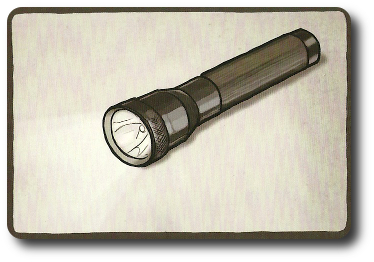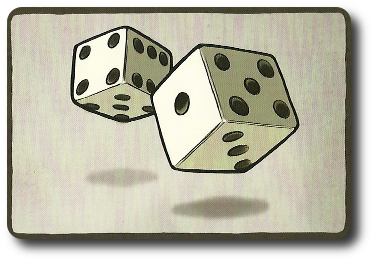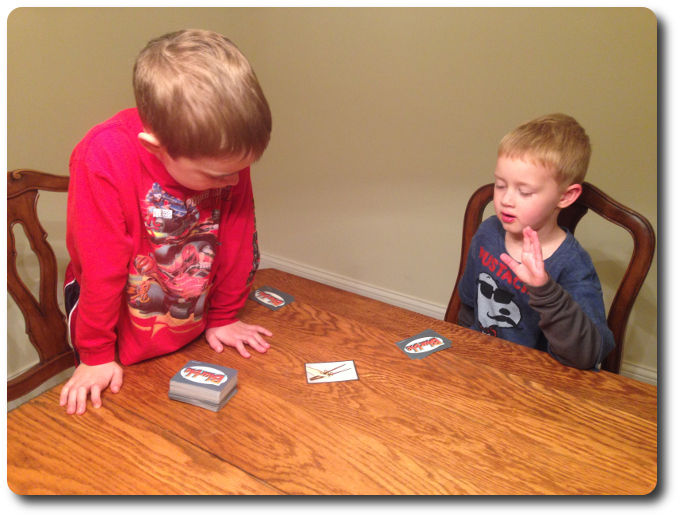
The Basics:
- For ages 6 and up
- For 2 to 12 players
- Variable game play length
Geek Skills:
- Active Listening & Communication
- Counting & Math
- Logical & Critical Decision Making
- Reflex & Speed
Learning Curve:
- Child – Easy
- Adult – Easy
Theme & Narrative:
- None
Endorsements:
- Gamer Geek rejected!
- Parent Geek mixed!
- Child Geek approved!
Overview
There’s a Chinese proverb that I’ve always liked. “The beginning of wisdom is to call things by their right names.” This proverb works great for this game, despite it’s unrelated deep philosophical undertones. You have to recognize images for what they are, or at the least, what you think they are. From there, you have the right information to make a decision. Of course, if you have no idea what the image is, no amount of wisdom is going to help.
Blurble, designed by Grant Bernard and self-published by Bernard Games L.L.C., is comprised of 250 cards. Each card has a different image on it that represents 1 letter of the alphabet. Since there are only 26 letters in the English Alphabet, each letter is represented multiple times. About 9 to 10 times each, if my math is correct. The illustrations by Erin Koehler are colorful, clear, and well done. It should also be noted that the images do not have titles, which means some of the images will be interpreted differently without a means to determine which interpretation is correct.

Is this a flashlight or a torch? It’s both, actually.
Game Set Up
To set up the game, shuffle the cards and pass the deck to one player.
And that’s it.
Playing the Game
Blurble is played in turns referred to as “face-offs”. There are no set number of face-offs in the game, but players can determine how long a game will be played. See “Winning the Game” for more information. A face-off is summarized here.
Step 1: Draw a Card
The player who currently has the deck of cards is referred to as the “Blurbler”.
The Blurbler will face-off with the opponent directly to their left. The Blurbler draws a card and places it face-up between themselves and their opponent.
Step 2: Shout the Word
The two players now race to be the first to shout, coherently, a word that starts with the same letter as the name of the image represented on the card. For example, if the image was an “apple”, players could shout “aardvark” or “avocado”, just to name a few possibilities. There are a few rules, however, that must be followed when attempting to be the first to shout a word…
- Players must shout a word that is at least 3 letters long
- Players cannot say a word that has already been said during the game
- Players must use the full name of the world (an example given in the rule book is “fire hydrant”, not “hydrant”)
- Players cannot use proper nouns, numbers, and contractions
- Players cannot use words if the exact spelling is used in the image (an example given in the rule book states you cannot use the word “rain” if the image is a “rainbow”)
The first player to shout a “legal word” wins the card. The other players in the game not currently participating are the defacto judges that determine if words are legal or not. This is particularly important when two players interpret the card differently or when a player continues to shout an “illegal word”, in which case the table must keep telling them, “Nope, sorry. Not a legal word.” If the two players in the face-off shout a legal word at the same time or are so close together a winner is not easily determined, another face-off is started to break the tie.
Let’s take a look at another card and discuss possible legal words.

The image depicts “dice” which starts with the letter “D”. Both players must now think of another “D” word and be the fist to say it out loud. Possible legal words include:
- dinosaur
- data
- dirigible
Illegal words would include:
- dozen (number)
- Dad (proper noun)
- don’t (contraction)
Step 3: Continue
If the winner of the face-off was the Blurbler, they now challenge the next opponent in turn order sequence repeating the steps above until they are defeated. If and when the Blurbler is defeated, the deck of cards is given to the winner and they are now the Blurbler.
Winning the Game
The game continues until a predetermined victory condition has been met. The players are welcome to create their own victory condition, but 3 are provided in the rule book to help things move along.
- Play until a specific number of cards has been won (suggested number is 20)
- Play for a specific number of minutes
- Reduce the number of cards in the deck and play until all the cards are used
The winner of the game is the one that meets the victory condition. Normally, this is the player who has won the most cards.
Game Variants
A number of game rule and game play variants are provided with the game. Of particular note is the “Lighting Round” that is a slightly faster version of the normal game. The difference is that every player plays at the same time. Expect a lot of noise.
The other game variant worth mentioning is the rule change that requires players to name a word that starts with 1 letter BEFORE the first letter in the image’s name. For example, if the card had an image of an “ostrich”, the word needed to win the card would use the letter “N”. This was very challenging and kept all the players on their toes. Ever see an adult mentally go through the alphabet in their head over and over again? It’s hilarious.
House Rules
Like all Word games, players with a smaller and weaker vocabulary are at a serious disadvantage. We changed a few of the rules to help makes things easier.
- Players may shout a word comprised of 1 to 1 billion letters
- Players can say a word already mentioned during the game
- Players are not required to use the full name of the world, but the longer and more accurate name wins if there is a tie
- Players can use proper nouns, numbers, and contractions
- Players can use words if the exact spelling is used in the image
Essentially, we opened up the game and stripped out a lot of the rules. All our Child Geeks loved it, but it dramatically reduced the game’s difficulty and fun for older Child Geeks and adults.
To learn more about Blurble, visit the game’s website.
Final Word
The Child Geeks enjoyed themselves. They laughed when it wasn’t their turn and shook their little fists when they became frustrated. Each face-off was like a mini sprint and the Child Geeks were up to the challenge. According to one Child Geek, “The hardest part about this game is just staying focused on the card. You can’t listen to the other players at all!” Another Child Geek said, “I don’t like it when I don’t know what the card is, but I always like trying.” There were a number of times where both Child Geeks didn’t know what the card was meant to represent. We solved this dilemma by simply drawing a new card. Overall, however, the Child Geeks recognized and successfully completed just about every face-off. The few exceptions were not show stoppers. One aspect of the game the Child Geeks did not like was the need to remember which words were already said and the few rules that kept getting in the way of shouting a word. But, again, these were minor and did not detract from the game or the player’s enjoyment. It was obvious, however, when one Child Geek had an advanced vocabulary and their opponent did not. These ended as you would expect and some Child Geeks wanted to trade places with others. This is a good idea, but if you chose to do it, be careful how you go about it. Some Child Geeks felt “stupid” or “slow” when they were told to sit next to younger Child Geeks. Despite the few hiccups, the majority of Child Geeks enjoyed themselves and voted to approve Blurble.

My two youngest Child Geeks face-off while I adjudicate behind my cup of coffee – I take it black
The Parent Geeks liked the game’s concept and enjoyed playing it with their Child Geeks, but found little thrill in the game when playing with their peers. According to one Parent Geek, “I like this game, and think it’s great for families and kids, but I find it a bit boring when playing with adults.” Another Parent Geek said, “This is a stellar game for families and kids, but a mediocre game for adults.” Not every Parent Geek thought so, however. One Parent Geek said, “This is a challenging game if you are paired up against the right opponent. I’d hate to go up against a writer or a person in sales.” Hilarious. When the games were over, the Parent Geeks were split and could not come to a consensus resulting in a mixed approval from the Parent Geeks. Everyone agreed the game was great for their kids, but they could not determine if Blurble was the right game for adults.
The Gamer Geeks were not impressed with the game. According to on Gamer Geek, “This is a lazy game, in my opinion. All we have here is a deck of cards with pictures and a really loose framework of rules. I don’t think this is worth my time.” Another Gamer Geek said, “A good game for younger players as it makes use of gamification to help players think fast and use the alphabet, but come on, I play Advanced Squad Leader every other month. This is not a game for me.” Regardless of the poo-pooing, I made them play it. Were they challenged? You bet! Did they compete to win? Of course! Did they have fun? Not at all. The Gamer Geeks voted to reject Blurble.
This is one of those games you pitch to new players and the general response is lukewarm at best. Being the first to shout a word doesn’t sound epic or engaging. However, once the players started the game, they quickly realized that the game was not that easy. This is especially true when the players were evenly matched in both skill and vocabulary. The deciding factor is the speed of the mind. Most of the time the players’ minds were up to the task, but they had to bring their brains, wits, and tongues up to speed first. In all cases, the first couple of face-offs were slow and bumbled. Once players became comfortable with the game’s pace and focus, face-offs became faster and faster. By the time the games were over, players were shouting and making words very quickly except for those images that started with odd letters. The letter “X” for example. Not difficult to think of another “X” word, but remember that you cannot reuse words that have already been said. Turns out not a lot of our players had many “X” words in their brains.
The biggest speed bump this game has is ironically the foundation on which the game is built. If players do not recognize the image on the card or players see two different things, the game stumbles. Technically, neither player is wrong in their interpretation of what they are seeing, but nor are they right. It’s up to the other players who are not in the face-off to determine what the card is and what is a legal word. That, as you have probably guessed, creates a great deal of debate at the gaming table and players will get sidetracked if they spend too much time arguing for or against another player’s case. It didn’t happen often, but it happened enough to warrant comments from our players.
I was very impressed with the lack of downtime between the players, especially in a 12-player game. Each face-off is pretty fast, unless the two players competing take their time figuring out the word. Which, of course, never happens. More likely, the two players will shout themselves hoarse in an attempt to stumble upon a legal word. Swearing is also common. The game can start to feel repetitive, too. The only way to spice it up is to change the game’s victory condition or make the game shorter. One Gamer Geek suggested alcohol, but I think that’s a bad move. Caffeine would be a better choice for a game that requires speed.
I found Blurble to be an excellent game for the Child Geeks and their families. Parent Geeks really didn’t enjoy it much with just adults and the Gamer Geeks were bored with it. Setting aside the fact that Blurble is not a game that most adults might be drawn to, I think the game is an excellent and fun exercise for a Child Geek’s mind. It’s challenging but light, focused but casual. What stress the game induces is fleeting and quickly replaced by laughter as others stumble to say a simple word quickly and coherently. Perfect for teachers and families, in my opinion. I bet the right group at a party would enjoy it, too. Does this game sound interesting to you? If so, take a look at Blurble.
This game was given to Father Geek as a review copy. Father Geek was not paid, bribed, wined, dined, or threatened in vain hopes of influencing this review. Such is the statuesque and legendary integrity of Father Geek.



